Your Ultimate Guide to 2024 Year-End Fundraising: 5 Principles for Success
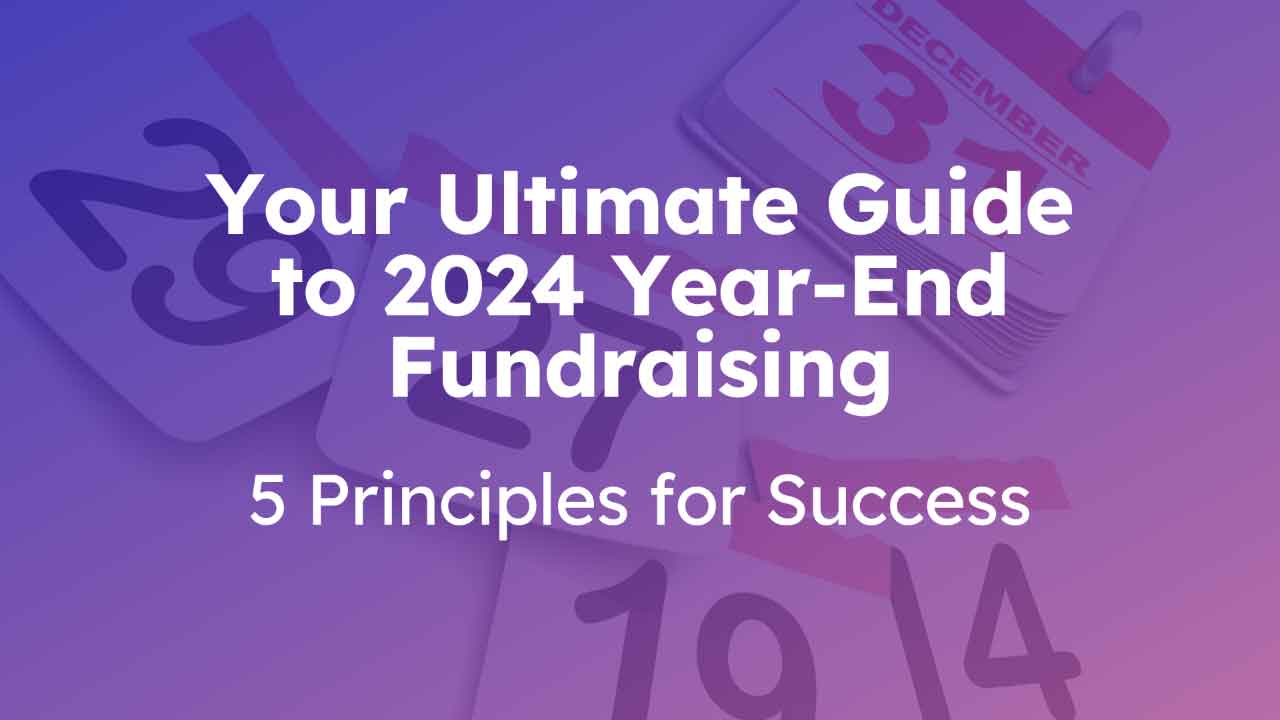
For nonprofits, year-end fundraising can feel like a maze of challenges. The year’s final weeks bring distractions and a barrage of competing messages. Standing out in a crowded field becomes daunting.
The calendar year-end is complex, but it’s a puzzle you must solve. After all, this is a critical time for many nonprofits. On average, most organizations raise up to 30% of their annual budget and 31% or more of their online revenue in December. However, the Fundraising Effectiveness Project’s Q4 2023 report found that year-end giving fell for the second year, down 2.8% from 2022.
Clearly, there’s work to be done. This guide offers practical strategies to help your nonprofit maximize its efforts during the crucial calendar year-end period. Specifically, we’ll touch on five tactics pulled from our “Year-End in July” podcast series:
- Incorporating data-driven planning
- Tapping into overlooked segments
- Crafting impactful stories
- Maximizing digital fundraising channels
- Cultivating donor fundraising and stewardship all year long
In addition to the challenges ahead, fundraisers also face a presidential election. This will undoubtedly increase the volume of appeals your donors receive. We’ve also created a communications calendar to help you map out your messaging for maximum impact.
We’ll start with five key strategies to guide your year-end fundraising success. Let’s dig in!
Work with Allegiance Group + Pursuant to craft a year-end strategy that cuts through the noise.
1. Use Data to Drive Your Year-End Strategy
In episode 1 of “Year-End in July,” we illustrate how data-driven planning can result in year-end success.
Understand the Power of Data
Leveraging data to understand your donors allows your nonprofit to drive the strategies that connect your cause to your donors’ passions. Before anything else, conduct a comprehensive analysis of your donors’ demographics and psychographics.
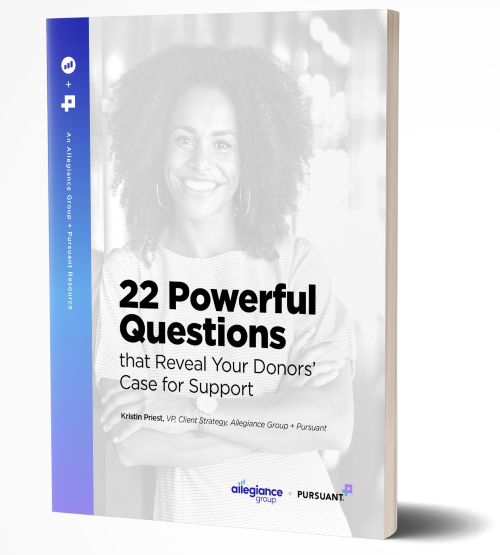
Explore the strategies you need to understand & appeal to your donors’ motivations.
Look to Past Campaigns for a Fuller Picture
It’s also helpful to analyze past year-end campaigns for insights. Analyze the profiles of people who gave to the previous year-end campaign to see if they differ somewhat or even dramatically from an overall donor profile.
Similar questions can be asked of pandemic “crisis donors” and monthly donors. The more you can understand who has supported your organization in the past, the more you can understand who’s likely to support you in the future.
Be Realistic When It Comes to Setting Goals
Setting clear and realistic fundraising goals can help nonprofits predict upcoming campaigns. To know how a year-end campaign will fare, look at the previous year’s performance alongside today’s philanthropic landscape and overall market trends.
With clear processes in place to know where revenue comes from, nonprofits can develop a deeper understanding of future campaign performance. Whether revenue comes from a previous campaign, a particular audience, or a giving package, clean data can show you where you’re going and eliminate potential problems.
Use the Tools at Your Disposal
Creating a customized year-end fundraising plan doesn’t have to feel impossible. With the right tools and strategies in place, your development team can start working backward from an end goal of December 31. When you understand the importance of stewardship and donor engagement in the year-end giving experience, you can begin to guide donors through the process months before.
Tools like GivingDNA can help your organization understand who your donors are and what they care about. This alone can enable nonprofits to drive better year-end giving campaigns.
Tips for Success
- Combine third-party data with first-party data for personalization and a donor’s case for support.
- Understand who donors have supported in the past so you can know who they’ll likely support in the future.
- Clean up dirty or messy data early on to identify problem spots.
Looking for help to utilize your data to drive your year-end strategy?
2. The Strength of Email Segmentation
Episode 2 of “Year-End in July” discusses the benefits of identifying overlooked segments in your nonprofit’s year-end giving campaign.
Don’t Overlook Inconspicuous Donors
Identifying under-tapped donor segments is necessary to meet the needs of different types of donors. For instance, donors who regularly give to your organization will often make an additional gift in December if asked. So, extend a personal invitation to your sustainers to give more.
Mid-level donors are also often overlooked when it comes to year-end giving. This group generally makes up 5% of your overall giving population and can provide a quarter of your revenue, which gives you a perfect opportunity to practice radical stewardship. A heartfelt thank you over the phone can often lead to greater giving.
Make It a Priority to Engage Lapsed Donors
The cost to re-engage a lapsed donor is usually less than the cost to acquire a new one. So, from a cost-benefit perspective, engaging with those already in your donor base makes sense.
Put an offer in front of LYBUNT donors (those who gave Last Year But Unfortunately Not This) that you know will resonate. Identify what you know about them and find out what campaigns they’ve been drawn to and supported in the past. By digging into various facets of segmentation, you can use personalization to increase their engagement.
Always Extend Invitations to Give
The end of the year is also an excellent time to ask donors to upgrade. One of the most popular strategies is to offer a match to nondonors. The infrequency of match offerings is an exciting way to entice new donors. It also yields the highest response rate of any type of giving.
Another strategy that may feel counterintuitive is to appeal to downgraded givers. Sending a targeted appeal to those who have recently downgraded their giving can often prompt another gift at the end of the year.
Tips for Success
- Narrow in on segmentation to meet a donor’s needs.
- Reach out to LYBUNT donors in November and December. A good story can always prompt someone to give again.
- Offer a match to donors, as this form of giving often has the highest response rate.
3. Tell Stories that Make You Stand Out from the Crowd
In episode 3 of “Year-End in July,” we discuss the power of storytelling in fundraising. The stakes are high for year-end giving campaigns. You must differentiate how your nonprofit is unique amidst a crowded field of similar organizations.
Creative storytelling practices can help you rise above the rest, especially when you can go beyond merely telling donors what you do and how you do it. Instead, invite your supporters to join your organization’s impact. Connecting with donors through compelling stories and images is integral to year-end fundraising strategies.
Home In on the One Thing You Do That No One Else Does
Identify your unique value proposition (UVP). In the crowded landscape of December giving, it’s easy to blend in with other nonprofits and struggle to stand out. Your UVP is critical to structuring your year-end campaign narrative.
Consider these questions:
- What do you do that no one else does?
- What are your donors saying to you?
- What matters to your donors?
- What are they responding to in terms of asks?
List the most popular topics, and remember that people give to people, not organizations. By focusing on outcome language — what you alone can do because of your unique impact in this world — donors will naturally gravitate toward giving.
Look and Listen for the Stories Around You
Collect compelling impact stories within your organization. Many nonprofits struggle with this, but it isn’t impossible — you just have to know where to look.
Practice open dialogue with your team and with donors. This allows for ample communication and provides the chance to get stories.
Create a culture of storytelling by inviting everyone to identify potential stories. It’s easy to center work on one or two departments, but allowing every department to identify potential can make a world of difference. Beyond your staff, pose a question in a newsletter and ask folks to send in a picture with their answer.
You can also find stories while scrolling through social media. Gather stories from clients, staff, and supporters when they post about your organization.
Show a Little Emotion Along the Way
Don’t be afraid to use emotional appeals to connect with donors. For instance, imagery is a powerful component of year-end campaigns because photographs tell a story. Images become live conversations when both the sender and receiver look at the same thing. Ensure photographs always direct viewers to the content you want them to read.
An emotional narrative also enables you to show, not just tell. When donors face two appeals — one a story, the other a collection of facts — feelings win out every time. Make an emotional connection with donors so they can remember and engage with a story only you can tell.
Let Social Media Do What It Does Best
On the creative side, integrating storytelling across communication channels can set your organization apart. Take advantage of each channel’s strengths to cover multiple touchpoints.
If you’ve gotten a head start on year-end strategy planning, consider employing new strategies, such as inviting influencers or ambassadors to spread the word about your nonprofit organization. The extensive social networks of these individuals can quickly expand your reach and bring in new donors — all because they believe in the good your team does in the world.
Tips for Success
- Give voice to your brand story to create connections.
- Use emotional appeals and multiple touchpoints to get your point across effectively.
- Home in on outcome language so donors understand your organization’s unique impact on this world.
4. Harness Digital for Maximum Visibility
Episode 4 expands on the growing role of digital fundraising in year-end campaigns. Direct mail is no longer the only game in town for raising money in December. Nonprofits can now harness multiple digital fundraising channels to educate and inform donors, allow them to see the people behind the heart of their mission, and hear real stories of change.
By leaning into a full-court press that includes email, social media, and your website, you can expand your reach and get your message out.
Building an effective online fundraising strategy starts with walking through your website as if you’re a first-time visitor. Think like a consumer as you approach your site. Consider everything from navigation ease and donation button prominence to overall color aesthetics, clarity of message, and second chances for re-engagement.
If you feel stuck and need help to make a decision about your website, simple is always better. Simplify the information present and ensure digital forms are easy to fill out.
Also, lead with mobile. Users who want to scroll through a website and click on a donate button should be able to do so quickly and easily.
Use Social Media for Storytelling
Using social media platforms to engage donors in your year-end campaign is critical. Let each channel make a specific community-driven ask. Specifically, extend a call to action (CTA) toward engagement, awareness, or overall reach, depending on the particular channel.
Build in fundraising rhythms throughout the year to provide donors with multiple opportunities to give. When you can work with social media’s unique algorithms to get your message — including the CTA to donate — in front of fans, followers, and friends, the wheels will start to click.
Put a blended message in front of people, and they’ll naturally see the connective thread between the different modes of communication.
Segment Email Audiences
Don’t forget to optimize email campaigns for year-end giving. The more you can do now to clean up lists and gain integrity around future recipients, the better off you’ll be when the campaign kicks off.
When you write the campaign series, look at the puzzle pieces to see if you can answer the question, “Who should get what?” Diversify your lists to avoid overwhelming potential donors. Recipients will then have time to rest between email campaigns while you ensure your emails are accessible to every type of giver.
End-of-year campaigns that perform well often do so because the communications roll out at a certain cadence. What’s more, the email content is coordinated well in advance, and it shows. For instance, through a nine-email series from November 1–16, 2023, the Minnesota Zoo Foundation (MFZ) raised more than $137,000 — 37% more than its goal. It also surpassed its 2022 total by 11%. Read the full case study.
Don’t Discount the Power of Video
The power of video content to enhance your digital appeal can’t be overstated. Just as interactive graphics can be incorporated into emails, elements like video are more engaging than static images and can stimulate digital viewers.
Video helps bring ideas and messages to life; in the digital space, you can leverage even more of these assets. By featuring multiple story threads that include video, you give individual donors the necessary tools to impact your organization’s life.
Tips for Success
- Gather images, assets, and anything else you’ll need for a year-end campaign as early as possible.
- Capitalize on social media by letting each channel do what it does best.
- Walk through your website like a first-time visitor to scope out problem areas.
5. Leverage Stewardship to Inspire Your Most Passionate Donors
In episode 5, we lean into the importance of donor retention and loyalty. November can’t be the only time your organization thanks those who have supported it financially. Rather, stewardship is a practice that must happen throughout the year.
When cultivating donor relationships and stewardship, thoughtful approaches will be rewarded and help your organization grow. By employing surprise and delight tactics and prioritizing human interactions throughout the year, your year-end campaign will be the icing on the cake.
Create Cultures of Appreciation
There are numerous ways to show donor appreciation during year-end giving campaigns, but a handwritten thank-you note can go a long way. If you haven’t already, invite volunteers, clients, and other staff members to help with this activity.
Organizations can also practice fun digital engagement by including a free download, a tip about celebrations, or recipes on your website. For faith-based organizations, this can be particularly significant around religious holidays.
Finally, one last idea is to include a voice broadcast thanking donors for their gifts. Hearing a person’s voice directly in your ears can be quite powerful, whether it comes from an executive director, program staff, or the very people you serve.
Build Personalized Communication Plans
Nonprofit stewardship and donor relations strategies can also benefit from personalized donor communication plans. No matter the budget, high-impact cultivation can happen quickly. A cell phone can often do the trick, capturing the heart of your organization’s mission and vision.
Try posting an uncurated video on social media just as you step onto an airplane or walk into a room full of clients. The video may not be as high-quality as an expensive-looking fundraising video, but it certainly comes across as more authentic.
More than anything, think outside the box regarding stewardship and cultivation. Donors will feel appreciated, which will make them want to give again.
Go the Extra Mile
Hosting donor appreciation events and recognition opportunities can also go far. A behind-the-curtain peek at your organization is a compelling touchpoint, especially for those in the public media and arts and culture spaces.
Imagine what it might mean to give folks an inside look at your team taking care of animals or putting on a performance. When people see what’s happening at your organization, they start to understand what it’s like to be in your organization.
Finally, end the year by throwing an in-person appreciation party, especially if you’re local to those you serve. This is the perfect complement to the months of the year marked by thankfulness, generosity, and festivity.
Remember, Clarity Is Key
Just as a little celebration can go a long way, so can ensuring transparency and accountability in stewardship. In addition to thanking donors often, sincerely, and profusely, don’t shy away from reporting the impact.
Be specific with what their dollars have accomplished. This gives you another opportunity to thank them and allows for further clarity in spending.
Accountability also means owning and correcting any mistakes and issues on behalf of your organization. By resolving individual complaints and apologizing when necessary, you create goodwill. As a result, it’s much easier for people to support your organization down the road.
Tips for Success
- A handwritten note can go a long way; pop one in the mail today!
- Employ elements of surprise and delight in stewarding your donors.
- Resolve individual complaints before they become more significant obstacles.
Putting It All Together: Crafting Your Year-End Fundraising Plan
Crafting a comprehensive year-end fundraising campaign can seem daunting. Use this Year-End Campaign Planning calendar to break down your objectives by date and make your goals more attainable. Given the upcoming presidential election, you’ll want to start early. Let’s go month by month.
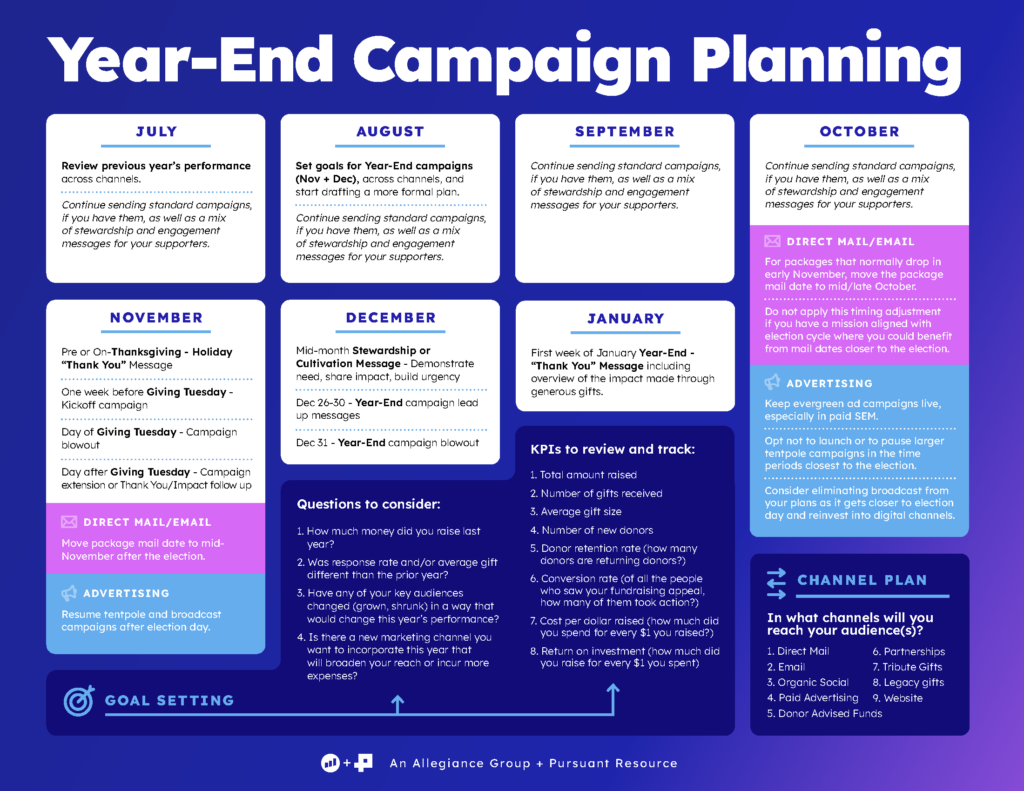
Year-End Campaign Planning Infographic
Download this infographic
Download a printer-friendly version.
October
Develop your campaign content in the first few weeks of this month. Due to the presidential election, you may want to roll out your year-end giving campaign toward the end of October.
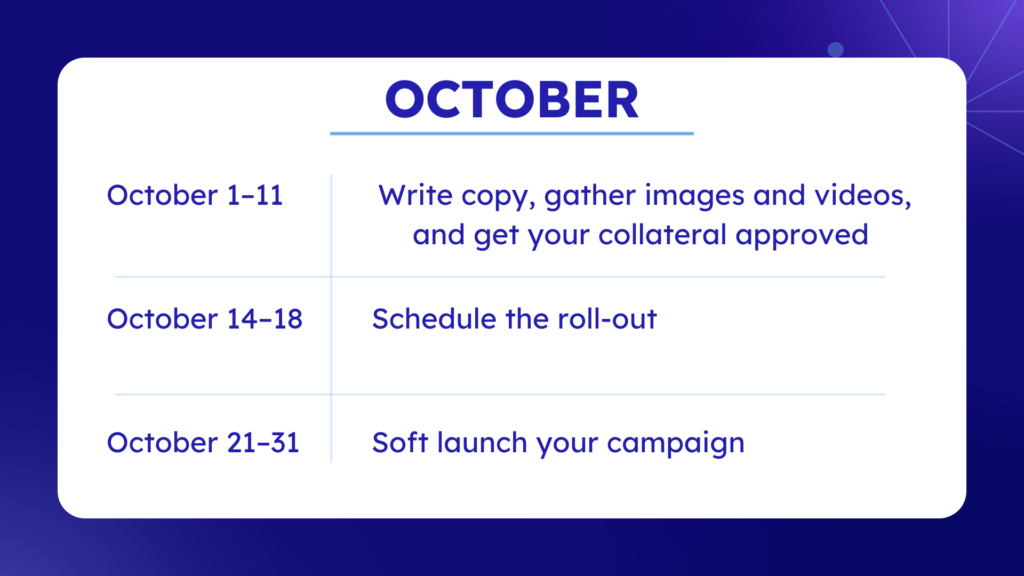
At this point, focusing on engagement is often most effective. Use engaging visuals, stories, and data to share the impact your donors have made.
Your goals should be to engage donors, reactivate followers, and remind supporters of your services. With that in mind, choose quality over quantity. After all, you’ll be competing with a barrage of election fundraising. Here’s a suggested cadence:
- Use your social channels to bring good news to your followers through daily posts.
- Set emails to hit inboxes every other day at the most. Be sure each email brings value to the audience, even if it’s a feel-good testimonial.
- Plan for a direct mail piece to drop 3–5 days into this campaign. This eye-catching piece should show donors the impact they’ve made.
While the content and design shouldn’t necessarily say “Year-End Giving,” it should mirror the themes of your appeals through colors and design elements.
November
Unless your organization is directly tied to the presidential election, we suggest taking the first week of November off. Don’t worry, you have time — because the Thanksgiving holiday is late this year, Giving Tuesday falls in December.
One caveat: If your services will be cut or suspended due to the presidential winner, you may want to send appeals in the days after the election to capture “rage giving.” This blog post discusses fundraising in an election year in more detail.
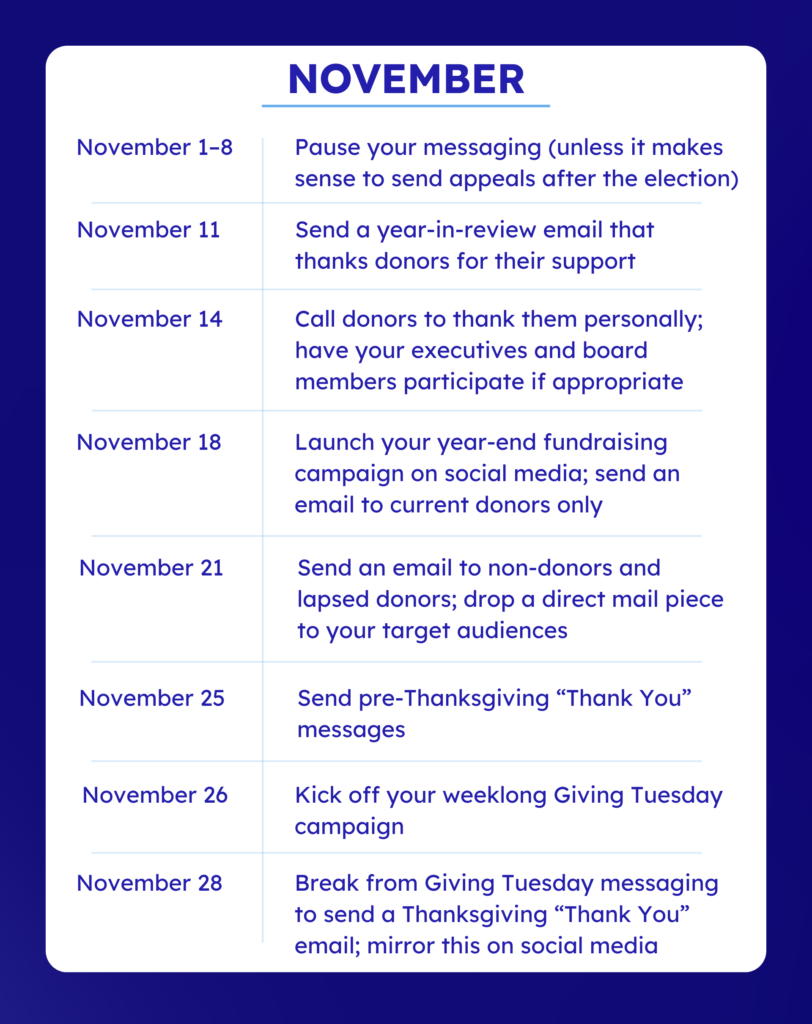
December
In December, you’ll continue stewardship or cultivation messaging that demonstrates need, shares impact, and builds urgency.
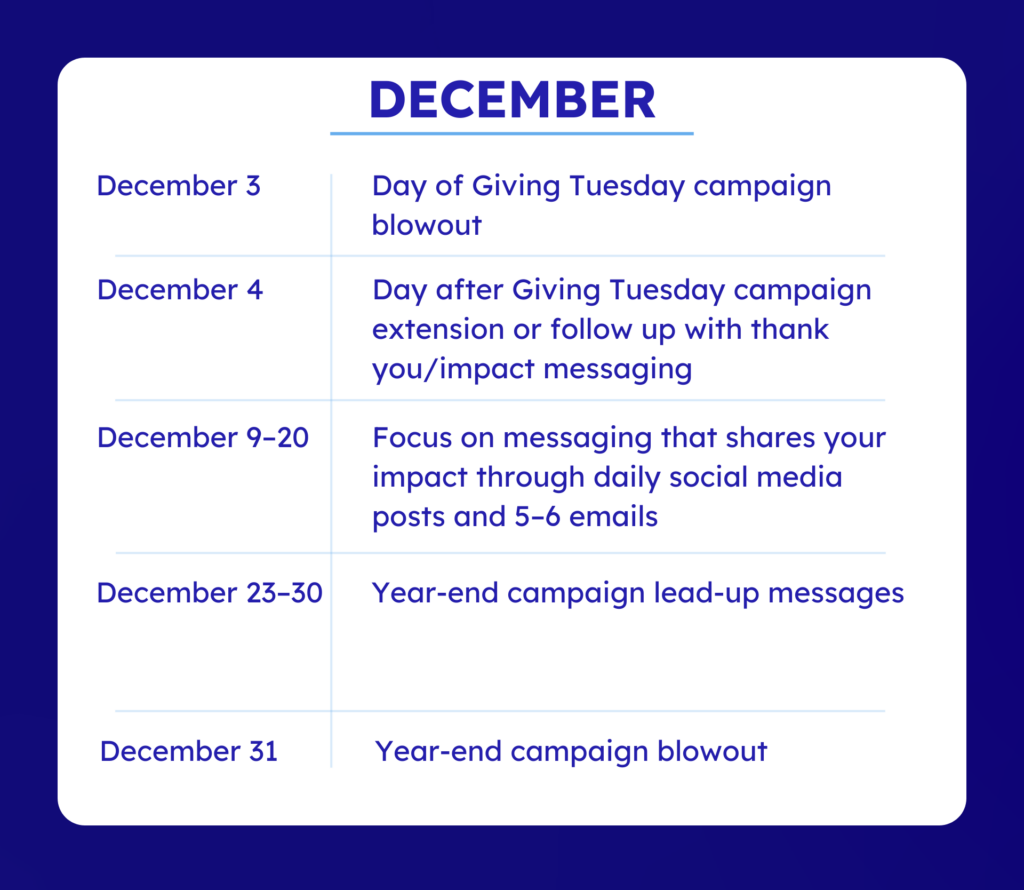
As we said at the beginning, year-end fundraising is complex. This guide aims to simplify the process so you can end the year on a strong note.
If you still feel stuck, these tips can help:
- Create a detailed campaign timeline. Start with December 31 and work backward to see what needs to happen by specific dates. You can also see what stories, images, and videos you need to have queued up and ready to go at different intervals along the way.
- Build a cohesive brand identity for your campaign. There’s only one you. What unique value does your organization bring to the world? By telling the story only you can tell, your donors will know what their dollars can accomplish.
- Engage volunteers and ambassadors in the process. When you give volunteers a stack of cards to handwrite a message, you equip those already invested to further their impact. Also, ask volunteers or ambassadors to share a CTA for your organization on their social media channels to increase your reach exponentially.
- Set up a monitoring and evaluation system. It might seem scary at first, but giving people an opportunity to weigh in, express their thoughts, and evaluate their experiences can often be precisely what they need to feel more invested.
- Be prepared to adapt and respond to changes. Change is the only constant, and year-end campaigns are no exception. Be prepared to pivot when pictures don’t come in, stories aren’t turned in on time, and faithful donors don’t give as generously as they have in the past.
More than anything, err on the side of gratitude. Thank supporters and donors for their ongoing commitment. Blow them away with the gratitude only you can give. Make them feel appreciated by pointing out the impact of their generosity. Give them a reason to keep you in mind when December rolls around next year.
Our team at Allegiance Group + Pursuant can help you define and execute a year-end strategy that rises above the election year noise and delivers maximum impact. Reach out to us today, and let’s get started.
Listen to Each Year-End in July Podcast Episode
Podcast #1: Year-End Fundraising in July: Leveraging Data to Prepare for Your Best Year-End Yet!
Podcast #2: Year-End Fundraising in July: Overlooked Segments You’ll Want to Engage with at Year-End
Podcast #3: Year-End Fundraising in July: Creative Storytelling Practices to Make Year-End Asks Pop!
Podcast #4: Year-End Fundraising in July: Incorporate Digital Fundraising Into Your Campaign
Podcast #5: Year-End Fundraising in July: The Crucial Importance of Stewardship Throughout the Year
Recommended Reading and Research Materials
2023 GivingUSA Annual Report on Philanthropy
Tools and Software to Enhance Your Fundraising Efforts
Other Related Blog Posts and Articles
Navigating the Political Storm: Crafting Resilient Fundraising Strategies for an Election Year